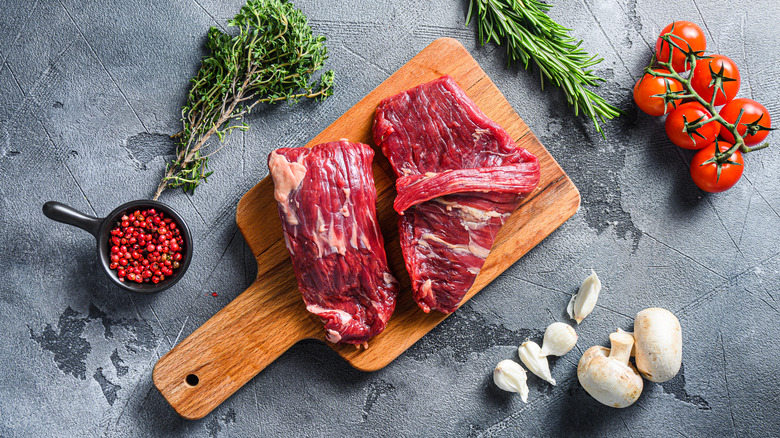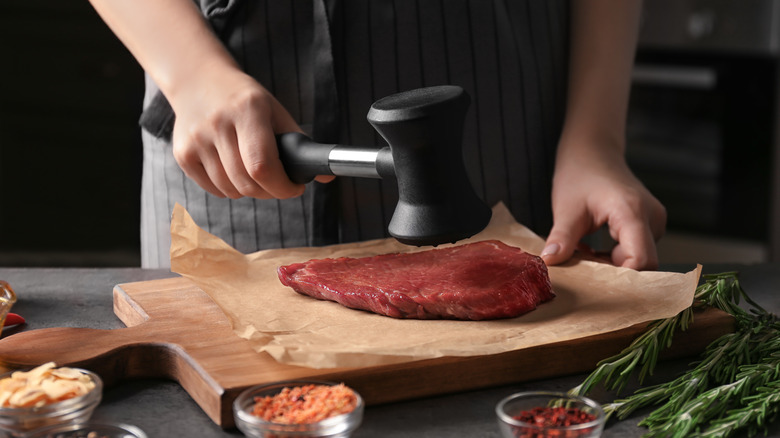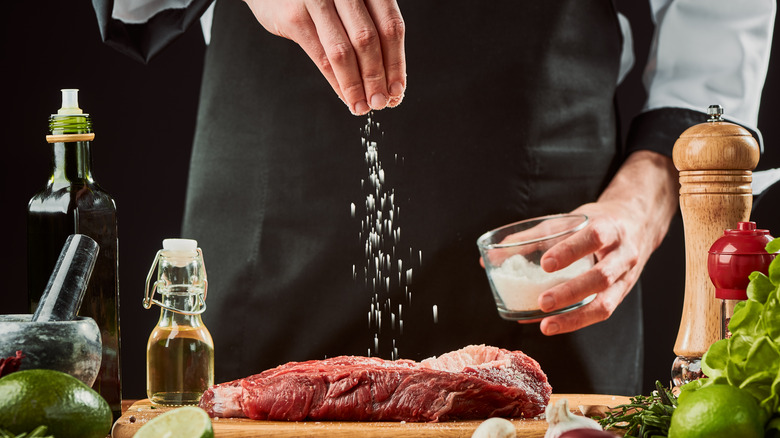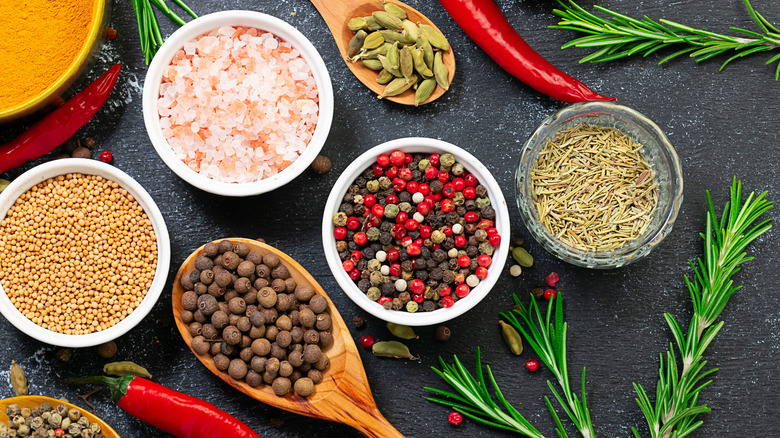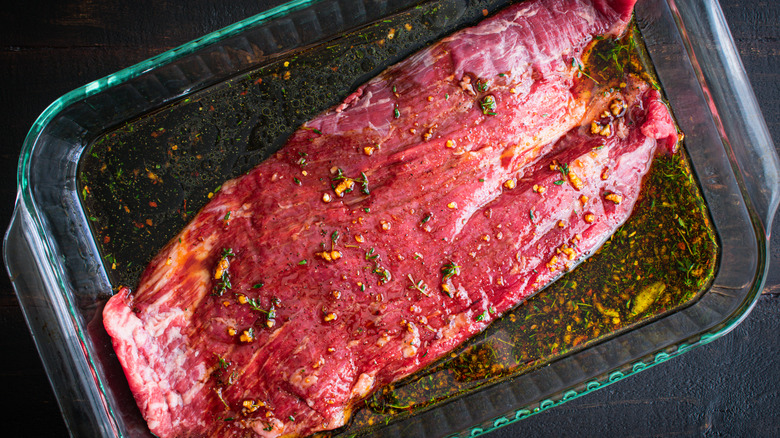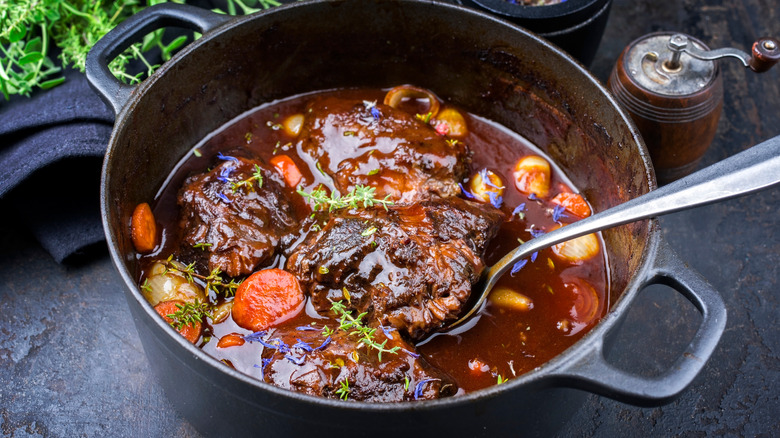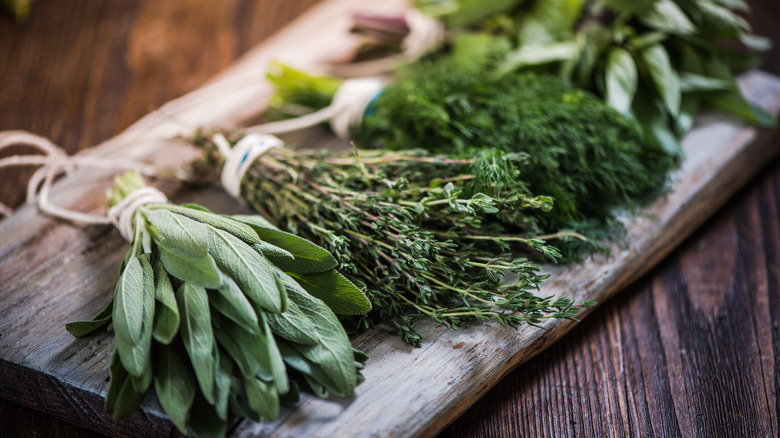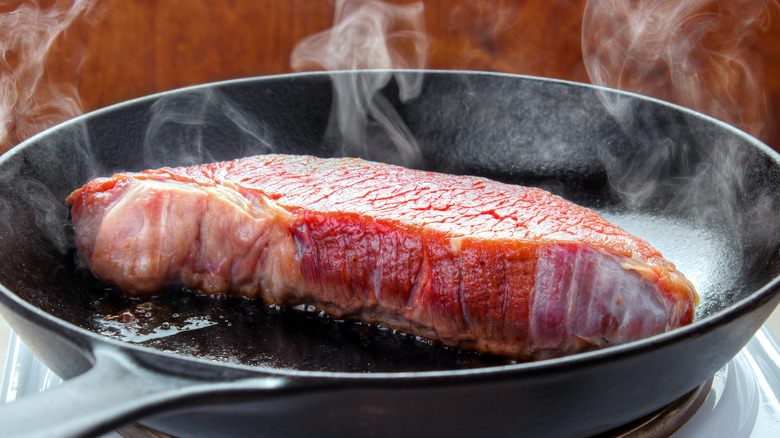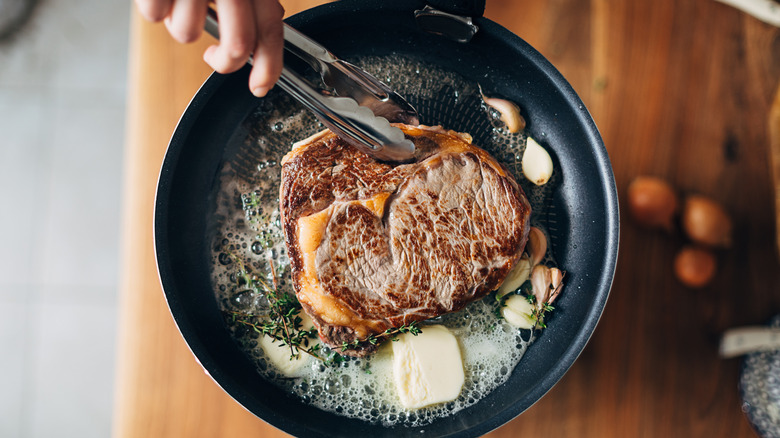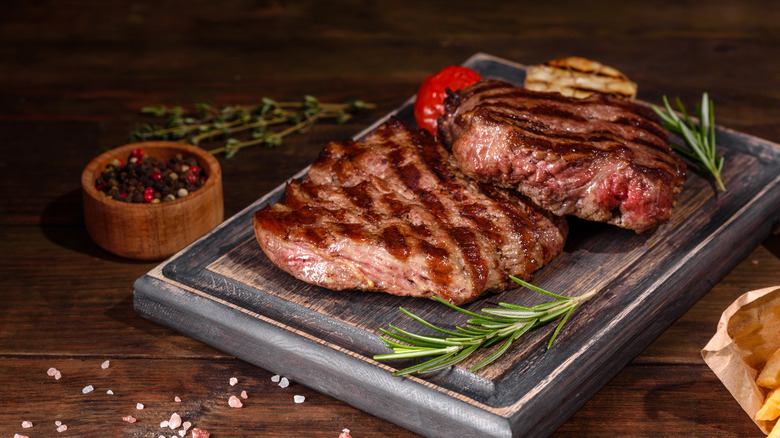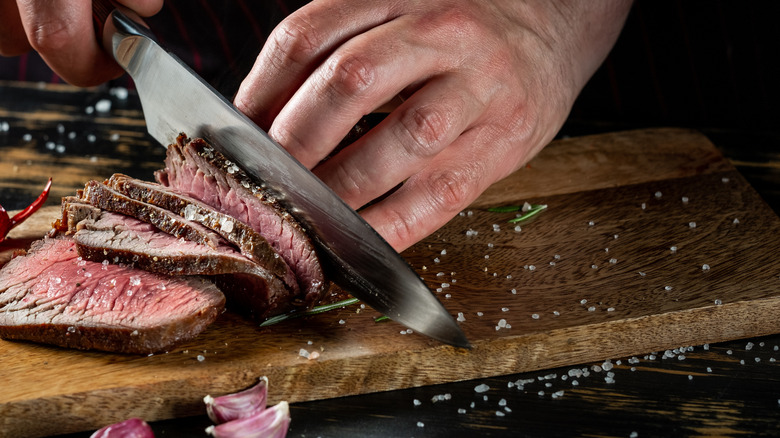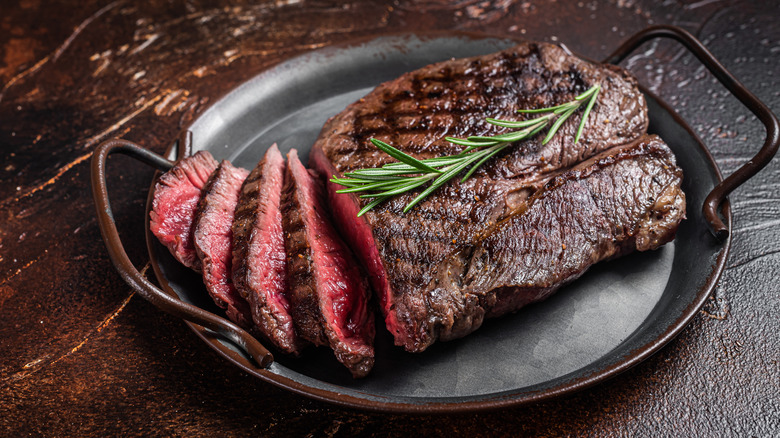12 Easy Ways To Improve A Cheap Cut Of Steak
With the price of beef (and food in general) on the rise, it's a great time to start cooking more reasonably priced cuts of steak that usually fly under our radar. Flank steak, tri-tip, flat irons, London broil, sirloins — you've probably glanced over and passed on these steaks at the grocery store, and we understand why. These affordable cuts of steak need a little extra TLC to make them tender and juicy. Sure, the price is appealing, but are the savings worth it when it comes to texture and flavor? With a few tips and tricks of the trade — we say, yes!
To show us how to improve on these cheaper, less-loved cuts of protein, we're turning to one of the best in the business: Katie Flannery, butcher and COO of Flannery Beef, a Northern California-based purveyor of high-quality, dry-aged USDA Prime Holstein beef. A third-generation butcher, Katie oversees Flannery's dry-aging program, works directly with customers to provide custom cuts, and manages the online retail business, which ships nationwide. Read on to learn Katie's best tips for turning budget-friendly steaks into beautifully tender, juicy dinners.
1. Pound the meat with a mallet
The fastest way to tenderize a budget cut of steak is to pound it. By breaking down the connective tissue in the meat before cooking, you'll eliminate some of the chewy, leathery texture, making the steak more enjoyable to eat. Steaks with long, tough muscle fibers — like top round, top sirloin, and eye of the round — particularly benefit from pounding.
A meat mallet is a proper tool for pounding meat and boasts two sides: flat and spiky. "The spiky side is meant for tenderizing by physically breaking down dense tissue and fibers of the meat — it basically masticates the surface," Flannery says. "The flat side is for pounding to make it thinner but not necessarily alter the texture." If you don't have a meat mallet, fret not. You can use other things in your kitchen, like a cast-iron skillet, rolling pin, or even your fist. Whichever tool you utilize, use small and steady thumps instead of brute force, which will rip apart the meat.
If you're short on time, you can purchase pre-pounded meat called cube steak. It is one of the most inexpensive yet flavorful tenderized steaks readily available. Cut from the top or bottom round, cube steak is used in chicken-fried steak. This popular American dish features thin steaks coated with seasoned flour and eggs, then deep- or pan-fried — like chicken — in oil until crisp and golden.
2. Sprinkle salt over the steak
When salt is sprinkled over a steak, the moisture inside it seeps to the surface, where it dissolves the salt. The briny liquid then gets reabsorbed into the steak, breaking down the lean muscle proteins and making the meat more tender and flavorful. "Salting and letting a steak rest for a few hours, or even overnight in the fridge, will give you a tenfold return on that time investment," Flannery told Tasting Table.
Flannery explained that since a longer salting time will improve the overall result, you'll want to pull out as many tricks as possible for a tougher cut than a more tender one. "Cuts from the top sirloin are some of the best cheaper options, so you can be faster and loose with those. If you're cooking up steaks from the top round, you'll want to give it as much help as possible."
When salting your steak, leave granulated salt in the shaker. Instead, Flannery suggests using Diamond Crystal kosher salt, known for its coarse texture and purity; she believes its grains are perfectly sized regardless of what cut you use. "I like to have a different finishing salt, something that you can finish a sliced dish with, like a Maldon or other flaked sea salt, which melts right into a slice for the perfect bite."
3. Make a wet or dry brine
Many chefs turn to brines to deal with tough cuts of beef. A brine can be wet or dry and involves infusing food with salt to enhance tenderness and add flavor. The main difference is how the salt is applied.
When wet brining, a steak is fully submerged in a solution of salt and water (and aromatics, if desired), which hydrates the meat via osmosis. A proper salt-to-water ratio is important; stick to a cup of salt for every gallon of water. Bring the solution of salt and water to a boil, and let it cool completely before submerging the meat. One hour per pound is a good rule of thumb for the amount of time to let the meat sit in the brine.
For dry brining, a steak is rubbed with salt, sometimes along with spices. As the steak rests, the salt draws out moisture to the surface, which is then reabsorbed back into the skin, where it denatures the proteins and tenderizes the meat.
Flannery prefers a dry brine for steak and lets it sit overnight in the refrigerator, but she warns to avoid oversalting. "It's not like curing an egg yolk. You don't want to bury the steak in a bed of salt. Instead, use about 1/2 teaspoon salt per pound of steak."
4. Utilize an acidic marinade
A good and effective marinade will make lean steak less dry, more flavorful, and juicier while breaking down muscle fibers. "If you're starting with a cut that might not have the best level of tenderness, you want to make it shine in every other category. Marinades can help take the flavor of a finished dish to the next level," says Flannery.
The best marinades contain an acidic ingredient — like citrus juice, buttermilk, low-pH fruit, wine, or vinegar — that breaks down the proteins inside beef, leaving the meat softer. Flannery cites red wine vinegar as her go-to acidic component of marinades. She also enjoys using Coca-Cola, especially when braising beef, saying, "It adds sweetness to a dish and tenderizes the beef."
Regarding acidic marinades, Flannery warns not to make the mistake of thinking longer equals more tender. "I wouldn't go more than a few hours of marinating if you're working with a thinner cut like skirt or flank. If you're using a thicker cut, like a top sirloin, you could go overnight without negatively affecting texture."
We love marinating because it's a hands-off, time-saving method for tenderizing meat. You can make a marinade, add the steak, and let it soak in the refrigerator while you prep the other ingredients or dishes.
5. Rub with yogurt or buttermilk
An issue with highly acidic marinades is that they can turn meat tough, rubbery, or mushy if left too long to soak. So, many opt for dairy-based ingredients — like buttermilk and yogurt — because the lactic acid in dairy tenderizes meat gently and more effectively.
One of Flannery's favorite dishes is a tandoori-style beef kebab with a yogurt or buttermilk marinade seasoned with ginger, garlic, cumin, garam masala, cayenne pepper, and lime juice.
"Using a dairy marinade will give you a bit of an edge, tenderness-wise. I would say work with dairy if it fits the flavor profile you're aiming for."
If you decide to marinate your steak with yogurt, both unstrained and Greek yogurt work, but make sure to use unflavored or plain. Since Greek yogurt is very thick, you only need to apply a thin coating over your steak — or thin it with oil. For the best results, marinate the steak for at least a few hours and up to overnight.
6. Cook the meat low and slow
While preparation is key to tenderizing cheap cuts of steak, the cooking technique you use goes along hand in hand. We know that low-and-slow cooking techniques are great for turning tough chunks of beef — like brisket and chuck — into soft, fall-apart meat. But, as Flannery states, "At the end of the day, there isn't really a cut that does poorly when slow-cooked."
Braising is a terrific, no-fuss way to prepare tough cuts of steak. "When meat is cooked at a temperature of about 160 degrees Fahrenheit for a prolonged period of time, the collagen (tough connective tissue) starts to break down into gelatin," Flannery explains. The constant low temperature and long cook time work together to relax the tough muscle fibers, while the meat cooks in a seasoned liquid. This hands-off cooking method is convenient and effective.
Another slow-cooking technique that's great for turning out tender steaks is sous vide. This "under vacuum" cooking method involves sealing the steak in an airtight pouch and submerging it in a water bath set to a precisely regulated temperature. Immersion circulators maintain the water temperature so the steak is brought to that exact temperature without ever surpassing it. If you're looking for an effective slow-cooking preparation for tender steak every time, sous vide is a great choice. "Slow cooking is magic," adds Flannery.
7. Incorporate herbs for flavor
Herbs are a natural pairing that can elevate your steak from bland to brilliant. You can rub herbs directly onto your steak, use them in marinades, or incorporate them into aromatic sauces like chimichurri, as Flannery does. "I love chimichurri with steak. That's a pairing that will never get old in my book. Chopped parsley with a little lemon, capers, red wine vinegar, fresh chopped herbs, and garlic is heaven on earth," Flannery says, "and chimichurri is just as good as a quick 30-minute marinade as it is a sauce for plating."
Flannery prefers using fresh herbs over dry ones as their delicate flavors and aromas complement the savory taste of beef incredibly well. But she admits she'll use dried herbs for something like a pot roast. "Just remember to back off on quantity if substituting dry for fresh in a recipe. Dried herbs pack more punch because they contain less water than fresh herbs."
As Flannery points out, "There is no secret sauce or magic preparation to turn a tough steak tender. You will never replicate the tenderness of a filet mignon when you're working with something from the round." In instances like this, she'll ask herself questions about additions. "Knowing the tenderness isn't going to be amazing, what else can I add to the dish to make it a really fantastic experience that's flavorful? So I turn to something like herbs or marinades to give vibrancy to a tougher cut."
8. Sear steak in a cast-iron skillet
Cooking in a cast-iron skillet is a great way to add flavor to steaks. "Cast-iron skillets retain heat well and distribute it evenly. It's your best bet for getting a perfectly seared crust on a steak," says Flannery. A perfectly browned, caramelized crust translates to a fantastic flavor that any steak can benefit from.
Another benefit of cooking steak in a skillet is making a quick pan sauce with the drippings. Flannery typically uses wine, sherry, or broth to deglaze the skillet and make a simple sauce with the flavorful bits of food on the bottom of the pan. After boiling the mixture to concentrate the flavors, stir in some cold butter off the heat to finish the sauce and add glossy richness. A quick pan sauce takes only a few minutes to make and will add incredible flavor to cheaper cuts of steak.
When cooking leaner (cheaper) cuts of steak, Flannery prefers cooking them on the rarer side and aims for a temperature of 120 degrees Fahrenheit. "The meat will climb a few degrees once you remove it from heat, so I'm looking for a 125 degrees Fahrenheit finish," she says.
9. Baste with butter while cooking
Basting a steak with butter elevates it from good to extraordinary by adding rich flavor and fat. Cheaper cuts of steak are leaner and have less marbling, so using butter while cooking is a great way to infuse fat into the dish. After all, fat equals flavor!
To butter-baste a steak, Flannery suggests searing the steak on both sides, then adding unsalted butter to the pan, along with herbs and garlic. When the butter starts to brown, tilt the skillet and use a spoon to continuously scoop up the pooled butter mixture and pour it over the top of the steak, flipping it every minute or so for an evenly cooked center. "I know it sounds like you need four hands to achieve this, but I assure you it's worth the extra work," exclaims Flannery.
If basting seems too complex, you can use compound butter to flavor your steaks. Compound butter is made by blending softened butter with flavorings, like fresh herbs or seasonings, and is quick and easy to make. But, Flannery notes, "Adding a slice of compound butter to a plated steak looks so attractive, but you're going to get a better flavor if you baste. Throw some butter in the pan with the steak, add some herbs and garlic, and repeatedly drown the steak in a foaming bath of flavor."
10. Allow the cooked steak to rest
As tempting as it may be to cut into meat right after removing it from the heat source, you should always let it rest. This crucial resting period allows the constricted muscle fibers in the steak to relax, releasing pressure on the juices, which allows them to redistribute towards the edges of the meat. As a result, the steak will be evenly moist and flavorful.
A cooked steak should rest for at least five minutes — though 10 minutes is best. "It also depends on thickness," Flannery says. "A thinner cut will cool down faster than a thicker cut, so you don't need as much time to achieve the same result." If all you can spare is five minutes, even that amount of time will make a difference.
According to Flannery, tenting a finished steak with aluminum foil while it rests isn't all that necessary. "The amount of liquid that's going to be held within the steak depends on the steak's temperature, so how you get it from hot to cool doesn't really matter. You just want it to cool down before you slice into it," Flannery adds.
11. Slice the meat thinly
One of Flannery's top suggestions for improving a cheap cut of steak is to slice the cooked steak thinly. She reasons if you're after a tender cut of meat, the thickness of the slice is as important as cutting against the grain. "With tougher cuts, the thinner you make the slice that you're then going to put into your mouth, the better eating experience you're going to have. It's just the truth at the end of the day," Flannery tells Tasting Table.
The goal of slicing the meat thinly is to sever the long fibers running down the steak — all you need is a sharp knife. To slice the meat, make thin cuts across the grain, keeping in mind that the thinner you cut your steak, the easier it will be to chew. Muscle fibers in the steak run parallel to each other, so even thick slices cut against the grain will still contain a good amount of tough sinew to chew through. To avoid this, cut the slices as thin as possible. As Flannery explains, "A thinner cut is going to be easier for your teeth to go through. That's the best way to get ahead of things when dealing with a tougher cut."
12. Cut against the grain
Along with slicing the meat thinly, Flannery stresses how critical it is to cut a cooked steak against the grain. The grain refers to the direction the meat's muscle fibers are aligned. If you slice with the grain, the long muscle fibers remain intact and must be torn apart by your teeth, resulting in a tough chew. But if you slice against the grain, the muscle fibers will be shortened, resulting in tender, easy-to-eat bites of beef.
Flannery likens the muscle fibers to a bundle of toothpicks inside the steak. "If I take my knife and cut perpendicular to the length of the toothpicks, I've got a bunch of small individual pieces that make up that slice. But if I do the opposite and cut into the steak lengthwise, I'm going to try to chew an entire length of a toothpick, which is a lot harder to do than chewing a handful of little tiny toothpick parts," she explains.
But do all steaks need to be cut against the grain? "All cuts benefit from being cut across the grain, but some much more than others," says Flannery. For example, higher-priced cuts of steak — like filet mignon and tenderloin — have thin muscle fibers that are relatively easy to cut through. But cheaper cuts of steak — flank, hanger, and skirt, in particular — have long, thick muscle fibers that are more visible and defined and need to be handled appropriately.
